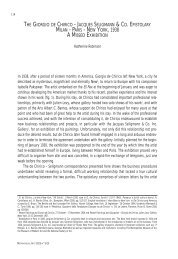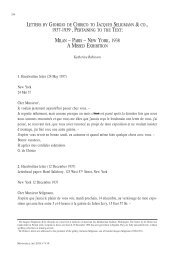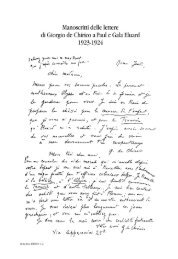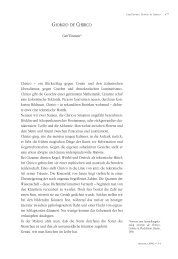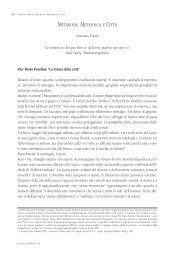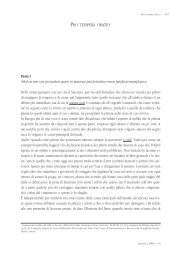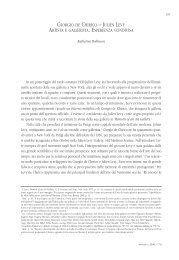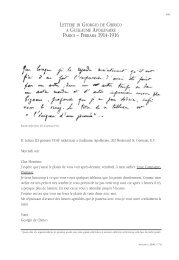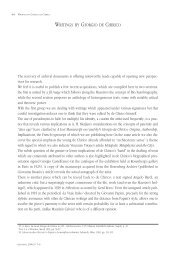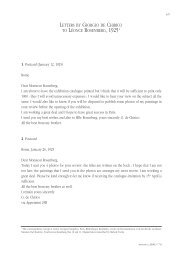293-356_08_Robinson ok.qxp - Fondazione Giorgio e Isa de Chirico
293-356_08_Robinson ok.qxp - Fondazione Giorgio e Isa de Chirico
293-356_08_Robinson ok.qxp - Fondazione Giorgio e Isa de Chirico
Create successful ePaper yourself
Turn your PDF publications into a flip-book with our unique Google optimized e-Paper software.
340KATHERINE ROBINSON: GIORGIO DE CHIRICO – JULIEN LEVY. ARTIST AND ART DEALER. SHARED EXPERIENCEis very touchy on the subject 3. that he might readily offer to repeat the superficial appearance of theearlier pictures, but would do them lifelessly as new pot-boilers 4. that he probably is stagnant.Now a good show would put him on the map again, and a mediocre show would kill him forgood. I can borrow here enough of the early work to make up that section (tho one or two for saleif you find any e.g. from Breton, would help) But the new group must meet your approval (theydon’t need to have any relation with the earlier pictures so long as they are good) otherwise youmust tell him that the whole show is off (or notify me and I will tell him in a letter) […].Lots and lots of love and gratitu<strong>de</strong>. Am sending you Soby’s bo<strong>ok</strong> ‘After Picasso’. Almost a daybo<strong>ok</strong> of the J. L. Gallery and might amuse you. Notice the attitu<strong>de</strong> towards <strong>de</strong> <strong>Chirico</strong> in the bo<strong>ok</strong>.” 54The title of the first of many publications by James Thrall Soby, After Picasso 55 , holds a doublemeaning. In his consi<strong>de</strong>ration of contemporary artistic movements, the author affirms that Picasso,possibly <strong>de</strong>spite himself, should henceforth be referred to as an ‘old Master’, consi<strong>de</strong>ring that at thetime the bo<strong>ok</strong> was written he had already been known as the greatest contemporary artist for 30years. The bo<strong>ok</strong> brings to the fore the work of a new generation of artists, the majority of whomwere trained in Paris and whose art, <strong>de</strong>riving also from Picasso’s influence, represented the latest<strong>de</strong>velopments in mo<strong>de</strong>rn art (as Levy points out, many of these artists – Dalí, Ernst, Eugene andLeonid Berman, Pavel Tchelitchew and Christian Bérard – were protagonists of the Julien Levygallery). The title After Picasso, would therefore indicate both a changing of the guard, which riskedleaving Picasso behind, and the heralding of new talent, which, inspired by his art, was to renewforms suggested by him through their own work, following i<strong>de</strong>ally in his footsteps.In After Picasso, the author presents <strong>de</strong> <strong>Chirico</strong> and Picasso in perfect parallelism as the twofoun<strong>de</strong>rs of 20 th century art. Their names are placed si<strong>de</strong> by si<strong>de</strong> each time he refers to their influenceon the younger generation, whose profound admiration for both artists constitutes the bo<strong>ok</strong>’sleitmotif. Soby holds that, while the contribution of painters of fantasy such as <strong>de</strong> <strong>Chirico</strong> and PaulKlee was acknowledged at the time, Picasso and Braque’s cubism had seemed more important dueto its contribution to the formal or<strong>de</strong>r of painting. Few would have foreseen that the literary paintingof <strong>de</strong> <strong>Chirico</strong> and Klee would supply the key for the revolt against cubism set in motion by theneo-romantics and the surrealists.In the neo-romantics, the meditative pathos of <strong>de</strong> <strong>Chirico</strong>’s paintings inspired a profoundly emotional,rather than intellectual, kind of painting. The surrealists employed the infinite world of dreamsand found, in what the author refers to as ‘technical romanticisms’ in <strong>de</strong> <strong>Chirico</strong>’s painting (an illusionof silence and isolation, long perspectives accentuated by vertical lines in rapid reduction), ameans of giving form to their nightmares. While the grouping together of incongruous objects in thepaintings of the Ferrarese period – thanks to <strong>de</strong> <strong>Chirico</strong>’s talent – produced compositions permeatedwith a profound sense of rest and conviction, the surrealist image expressed <strong>de</strong>liberate violence.Soby notes that it is for this reason that the unreality of <strong>de</strong> <strong>Chirico</strong>’s world was more acceptable thanthat of the surrealists.54J. Levy to M. Loy, May 27, 1935, copy of typewritten letter, Julien Levy Archive.55James Thrall Soby, After Picasso, Edwin Valentine Mitchell, Hartford, Dodd, Mead and Company, New York. 1935.METAFISICA 20<strong>08</strong>|N° 7-8



